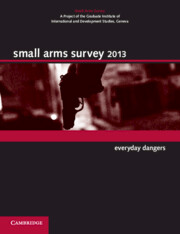Book contents
- Frontmatter
- Foreword
- Contents
- About the Small Arms Survey
- Notes to readers
- Acknowledgements
- Introduction
- Chapter 1 Everyday Dangers: Non-conflict Armed Violence
- Chapter 2 Too Close to Home: Guns and Intimate Partner Violence
- Chapter 3 Turning Points: Gang Evolution in Nicaragua
- Chapter 4 Guns in the Family: Mafia Violence in Italy
- Chapter 5 Survival at Stake: Violent Land Conflict in Africa
- Chapter 6 Trend Lines: Armed Violence in South Africa pages 132 to 137
- Chapter 6 Trend Lines: Armed Violence in South Africa pages 137 to 159
- Chapter 7 Second Wind: The PoA's 2012 Review Conference pages 160 to 168
- Chapter 7 Second Wind: The PoA's 2012 Review Conference pages 169 to 177
- Chapter 8 Trade Update: Authorized Small Arms Transfers
- Chapter 9 Burning the Bullet: Industrial Demilitarization of Ammunition pages 186 to 199
- Chapter 9 Burning the Bullet: Industrial Demilitarization of Ammunition pages 200 to 217
- Chapter 10 ‘Infernal Machines’: Improvised Explosive Devices
- Chapter 11 Price Watch: Arms and Ammunition at Illicit Markets pages 250 to 268
- Chapter 11 Price Watch: Arms and Ammunition at Illicit Markets pages 269 to 281
- Chapter 12 Captured and Counted: Illicit Weapons in Mexico and the Philippines pages 282 to 302
- Chapter 12 Captured and Counted: Illicit Weapons in Mexico and the Philippines pages 302 to 317
- Index
Chapter 12 - Captured and Counted: Illicit Weapons in Mexico and the Philippines pages 282 to 302
Published online by Cambridge University Press: 05 June 2014
- Frontmatter
- Foreword
- Contents
- About the Small Arms Survey
- Notes to readers
- Acknowledgements
- Introduction
- Chapter 1 Everyday Dangers: Non-conflict Armed Violence
- Chapter 2 Too Close to Home: Guns and Intimate Partner Violence
- Chapter 3 Turning Points: Gang Evolution in Nicaragua
- Chapter 4 Guns in the Family: Mafia Violence in Italy
- Chapter 5 Survival at Stake: Violent Land Conflict in Africa
- Chapter 6 Trend Lines: Armed Violence in South Africa pages 132 to 137
- Chapter 6 Trend Lines: Armed Violence in South Africa pages 137 to 159
- Chapter 7 Second Wind: The PoA's 2012 Review Conference pages 160 to 168
- Chapter 7 Second Wind: The PoA's 2012 Review Conference pages 169 to 177
- Chapter 8 Trade Update: Authorized Small Arms Transfers
- Chapter 9 Burning the Bullet: Industrial Demilitarization of Ammunition pages 186 to 199
- Chapter 9 Burning the Bullet: Industrial Demilitarization of Ammunition pages 200 to 217
- Chapter 10 ‘Infernal Machines’: Improvised Explosive Devices
- Chapter 11 Price Watch: Arms and Ammunition at Illicit Markets pages 250 to 268
- Chapter 11 Price Watch: Arms and Ammunition at Illicit Markets pages 269 to 281
- Chapter 12 Captured and Counted: Illicit Weapons in Mexico and the Philippines pages 282 to 302
- Chapter 12 Captured and Counted: Illicit Weapons in Mexico and the Philippines pages 302 to 317
- Index
Summary
INTRODUCTION
The sprawling collection of weaponry seized in the border town of Reynosa, Mexico, could easily have been mistaken for the arsenal of a well-equipped infantry battalion: hundreds of assault rifles, sub-machine guns, pistols, grenades, and grenade launchers arranged in eight rows that ran the entire length of the Mexican Army's spacious press room (AP, 2008). The massive cache—discovered during the pursuit of a high-ranking drug cartel member in November 2008—is illustrative of Mexico's thriving black market in small arms and light weapons, which is dominated by the country's powerful and well-financed drug-trafficking organizations (DTOs). Fuelled by billions of dollars in drug revenue each year, the cartels are among the best-funded non-state armed groups in the world.
There is little disagreement that the arsenals built with these funds are vast, but their precise composition and the sources of their contents are subjects of much debate. Do the DTOs have the ‘wealth and armies of nations’, as some claim? Does their wealth afford them access to weapons that are unavailable to armed groups of lesser means? Are there notable differences between the weapons acquired by the profit-motivated Mexican DTOs and those obtained by groups that have ideological or political ambitions and operate in other countries? This chapter attempts to answer these and other questions through data-driven analysis of illicit small arms and light weapons in countries affected by low-intensity armed conflict and high-intensity organized criminal violence.
- Type
- Chapter
- Information
- Small Arms Survey 2013Everyday Dangers, pp. 282 - 302Publisher: Cambridge University PressPrint publication year: 2013



